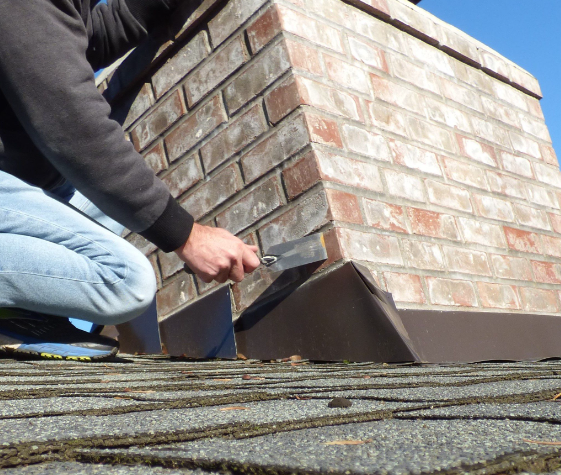Introduction: The Crumbling Hearth
Picture a cozy winter evening—the fireplace crackling the warmth enveloping you. But what if that comforting hearth starts to crumble? Chimneys those silent sentinels perched atop our homes endure harsh weather and wear over time. In this article, we’ll explore common chimney issues and how to repair them ensuring your home remains snug and secure.
Common Chimney Problems
Mechanical Fasteners
Those screws holding chimney caps in place? Not ideal. They create openings where water can seep in. Instead, consider using silicone caulking for expansion and contraction
Broken Bonds Between Mortar and Brick
Check for mortar separating from brick edges—prime spots for water infiltration.
Loose Aggregate:
A smooth mortar joint seals water out. If you notice sand and small stones falling out it’s time for a joint replacement.
Flashing Damage:
Inspect the flashing around the chimney base to keep water away from your home.
Poor Draft: If your chimney doesn’t pull smoke out effectively it might need professional adjustments.
Repairing Your Chimney
Assess the Damage: Look for broken mortar missing chunks or loose aggregate. These areas need repair to restore water-tightness.
Grinding Away Mortar: Use a grinder to remove an inch of existing mortar from horizontal joints (bed joints). Be cautious not to damage the brick.
Vertical Joints: Chip away at vertical joints (head joints) using a masonry chisel and hammer.
Safety First: Remember working on roofs can be dangerous. Use safety barriers or fall arrest harnesses when necessary.
Signs of a Damaged Chimney
Here are some telltale signs that your chimney might need repair:
Cracked Mortar: Inspect the mortar joints between bricks. Cracks or gaps indicate water infiltration and weakening of the structure.
Spalling Bricks: If you notice bricks chipping flaking or breaking apart it’s a sign of deterioration due to weather exposure.
Efflorescence: White powdery deposits on the chimney surface suggest water penetration. It’s often caused by salt leaching from the bricks.
Leaking Water: Water stains on the ceiling near the chimney or dampness in the fireplace area indicate leaks.
Soot Buildup Inside: Excessive soot or creosote buildup can lead to chimney fires. Regular cleaning is essential.
Damaged Flashing: Check the metal flashing around the base of the chimney. Rust gaps or missing sections can allow water to seep in.
Chimney Cap Issues: A damaged or missing chimney cap invites rain debris and animals into the flue.
Addressing chimney issues promptly ensures safety and prevents further damage. If you notice any of these signs consider professional inspection and repairs.
What are the Risks of ignoring Chimney Repairs?
Ignoring chimney repairs can have serious consequences for your home and safety. Here are the risks:
Structural Damage: Cracked mortar spalling bricks and deteriorating flashing weaken the chimney’s structure. Over time this can lead to collapse or costly reconstruction.
Water Infiltration: Damaged chimneys allow rainwater to seep into your home. This can cause interior water stains mold growth and rot in wooden structures.
Fire Hazard: Soot buildup creosote deposits and damaged flue liners increase the risk of chimney fires. These fires can spread to your home and endanger lives.
Carbon Monoxide Poisoning: A faulty chimney can’t effectively vent harmful gases like carbon monoxide. Inhaling these gases poses serious health risks.
Energy Inefficiency: Cracks and gaps allow warm air to escape during winter and cool air during summer. Your heating and cooling bills may rise significantly.
Decreased Home Value: An unsightly or unsafe chimney affects curb appeal and overall property value.
Prompt attention to chimney repairs ensures a safe efficient and comfortable home. Don’t neglect this vital maintenance!
DIY Maintenance Tips for Chimneys
Here are some DIY chimney maintenance tips to keep your chimney in good condition:
Regular Debris Removal: Clean out leaves twigs and other debris from the chimney regularly.
Inspect Connections: Check all connections between flue pipes and dampers for any issues.
Repoint Damaged Brickwork: If you notice damaged bricks consider re-pointing them to maintain structural integrity.
Metal Chimneys: Inspect metal chimneys for rusting or corrosion.
Replace Worn Gaskets: Ensure that gaskets around dampers are in good condition.
What Tools are Needed for DIY Chimney Maintenance?
For DIY chimney maintenance you’ll need the following tools:
1. Chimney Brush: Essential for cleaning the flue.
2. Extension Rods: Attach these to the chimney brush for sweeping.
3. Fireplace Cover: Seal the fireplace opening to prevent soot from entering your home.
4. Goggles: Protect your eyes during maintenance.
5. Dust Mask: Keep yourself safe from dust and debris.
Conclusion: A Sturdy Hearth for Generations
By addressing common chimney issues promptly you’re not just preserving your home’s integrity; you’re safeguarding cherished memories. So next time you gather around the fireplace appreciate the silent hero—the chimney—that stands tall against the elements ensuring warmth and comfort for years to come.
Remember a well-maintained chimney isn’t just a functional necessity; it’s a testament to the hearth’s enduring legacy.






